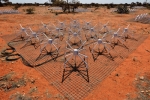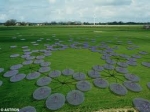Displaying items by tag: SKA
Murchison Widefield Array (MWA)
The Murchison Widefield Array (MWA) is a joint project between an international consortium of universities to build a low-frequency radio array operating in the frequency range 80–300 MHz.
The main scientific goals of the MWA are to detect neutral atomic Hydrogen emission from the cosmological Epoch of Reionization (EoR), to study the sun, the heliosphere, the Earth's ionosphere, and to study radio transient phenomena.
The MWA is the first so-called large-N array, fully cross-correlating signals from 128 phased tiles, each of which consist of 16 crossed dipoles arranged in a 4x4 square. The field of view is large by the standard of astronomical instruments, being on the order of 30 degrees across.
The MWA was to be situated at Mileura Station where initial testing had been conducted then moved southwest Boolardy station in outback Western Australia, at the Murchison Radio-astronomy Observatory (MRO), 800 kilometres north of Perth. This location offers a quiet radio environment and stable climate for observations.
The MRO is also the site of CSIRO's Australian Square Kilometre Array Pathfinder (ASKAP) and one of two candidate sites for the Square Kilometre Array (SKA).
In addition to the geographic link, the MWA is a technology and science pathfinder for the SKA.
SKA project
The Square Kilometre Array (SKA project) is a multi-purpose radio telescope that will play a major role in answering key questions in modern astrophysics and cosmology.
It will be one of a small number of cornerstone observatories around the world that will provide astrophysicists and cosmologists with a transformational view of the Universe. It will allow investigating galaxy evolution, cosmology and dark energy.
The Square Kilometre Array will provide a million square metres of collecting area. This huge increase in scale demands a revolutionary break from traditional radio telescope design.
The Square Kilometre Array will be the world's largest and most sensitive radio telescope.
Thousands of linked radio wave receptors will be located in Australia and in Southern Africa. Combining the signals from the antennas in each region will create a telescope with a collecting area equivalent to a dish with an area of about one square kilometre.

The SKA will address fundamental unanswered questions about our Universe including how the first stars and galaxies formed after the Big Bang, how galaxies have evolved since then, the role of magnetism in the cosmos, the nature of gravity, and the search for life beyond Earth.
The Square Kilometre Array is a global science and engineering project led by the SKA Organisation, a not-for-profit company with its headquarters at Jodrell Bank Observatory, near Manchester, UK.
An array of dish receptors will extend into eight African countries from a central core region in the Karoo desert of South Africa. A further array of mid frequency aperture arrays will also be built in the Karoo. A smaller array of dish receptors and an array of low frequency aperture arrays will be located in the Murchison Radio-astronomy Observatory in Western Australia.
- The SKA will be so sensitive that it will be able to detect an airport radar on a planet 50 light years away.
- The SKA central computer will have the processing power of about one hundred million PCs.
SKA Organisation
The SKA Organisation is the legal entity created to design, develop and operate the the Square Kilometre Array (SKA project).
Since 2008, the global radio astronomy community has been engaged in the development of the SKA as a major part of the 'Preparatory' phase of the project. The Preparatory phase ended in December 2011 and, following a number of major changes, the international SKA project has now progressed to the 'Pre-Construction' phase (2012-15) with the establishment of a new legal entity, the SKA Organisation, on 14 December 2011. The SKA Organisation will be based in the Alan Turing Building, The University of Manchester until October 2012, at which time it will move to a purpose-built building at Jodrell Bank Observatory in Cheshire, UK.
LOFAR
LOFAR is a very large connected radio telescope, using a new concept based on a vast array of omni-directional antennas.
LOFAR is a Low-Frequency Array for radio astronomy, built by ASTRON, the Netherlands Institute for Radio Astronomy and operated by ASTRON's radio observatory. ASTRON is part of the Netherlands Organisation for Scientific Research.
The project is based on an interferometric array of radio telescopes using about 25,000 small antennas concentrated in at least 48 larger stations. 40 of these stations are distributed across the Netherlands, five stations in Germany, and one each in Great Britain, France and Sweden. Further stations may also be built in other European countries. The total effective collecting area is up to approximately 300,000 square meter, depending on frequency and antenna configuration. The data processing is performed by a Blue Gene/P supercomputer situated in the Netherlands at the University of Groningen. LOFAR is also a pathfinder for the Square Kilometre Array. The Square Kilometre Array will be the world's largest and most sensitive radio telescope. The SKA will be built in Southern Africa and in Australia.
It is a global enterprise bringing together 11 countries from the 5 continents.





